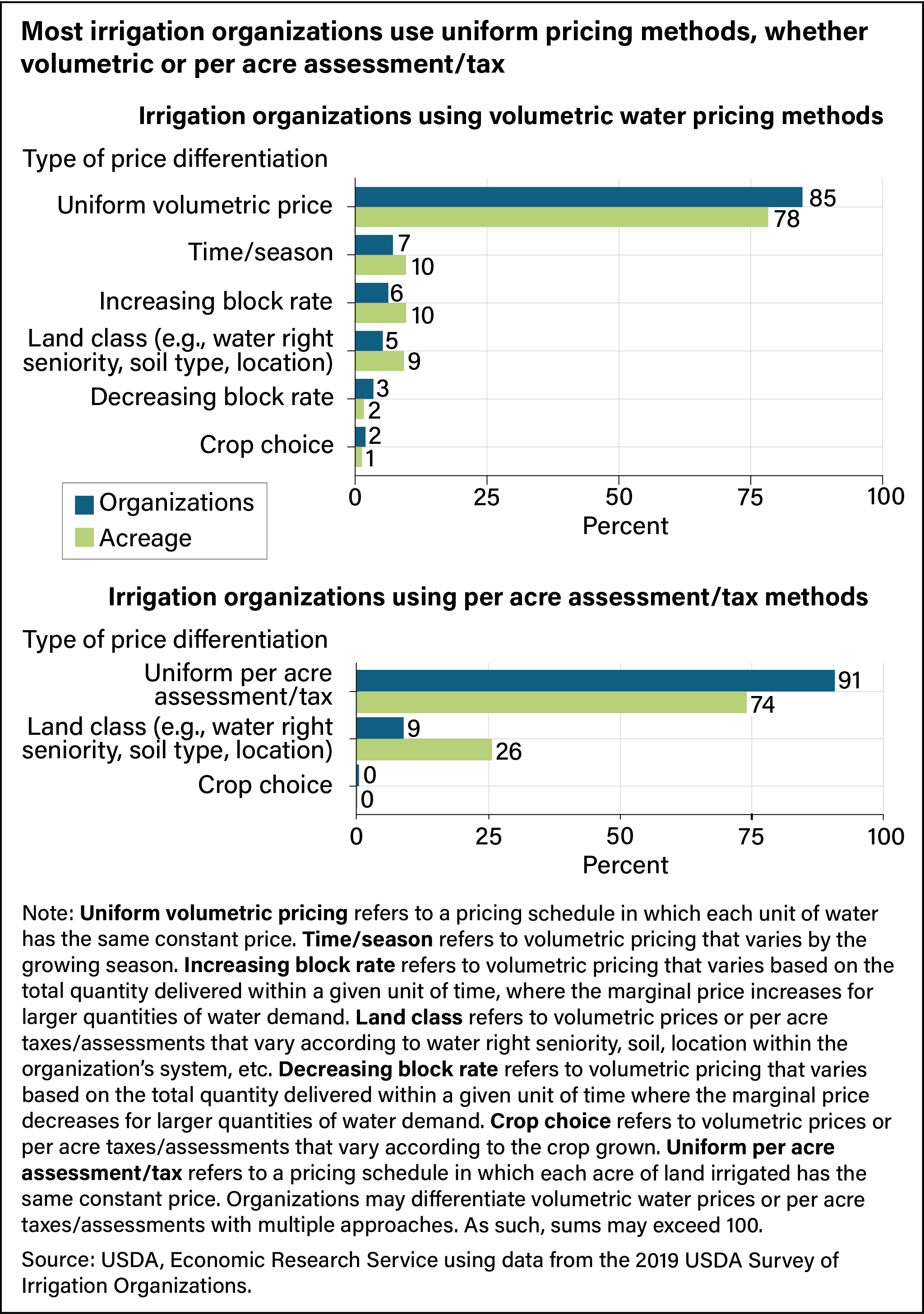
Most Irrigation Organizations Use Uniform Prices for Water Deliveries
- by R. Aaron Hrozencik, Nicholas Potter and Steven Wallander
- 7/29/2025
Irrigation organizations operate networks of diversion structures, reservoirs, canals, ditches, and pipelines to deliver water to farms and ranches. These organizations fund the maintenance of their systems through fees for water deliveries, which are generally done in three ways: volumetric pricing, which is based on the volume of water delivered; an assessment/tax per acre of land irrigated; or a combination of the two. The fee charged can determine, in part, on-farm water conservation.
To better understand how different pricing approaches are used, researchers with USDA, Economic Research Service (ERS) analyzed data from the 2019 Survey of Irrigation Organizations (SIO)—the first nationally representative Federal data collection effort aimed at organizations that deliver water to farms or influence on-farm groundwater withdrawals. Three USDA agencies (ERS, National Agricultural Statistics Service, and the Office of the Chief Economist) collaborated to develop and implement the survey.
SIO data indicate that 21 percent of organizations use volumetric pricing without any per acre assessments/taxes. The largest group, 44 percent of organizations, uses per acre assessments/taxes without any volumetric pricing. About 24 percent of organizations use a mix of volumetric pricing and per acre assessments/taxes. The remaining organizations (12 percent) do not report using volumetric pricing or per acre assessments/taxes.
The majority of organizations that employ volumetric pricing for deliveries (85 percent, or 78 percent of total acreage served by organizations that use volumetric pricing) use a uniform volumetric price (see top chart below). Two other approaches within volumetric pricing include altering prices based on time/season (7 percent of organizations, or 10 percent of total acreage) and an increasing block rate, in which more water use means an increased per unit price of water (6 percent of organizations and 10 percent of total acreage). The use of increasing block rate volumetric pricing may encourage on-farm water conservation as farms and ranches pay more per acre foot of water delivered throughout the growing season.
Of organizations that use per acre assessments/taxes (see bottom chart of figure), 91 percent (representing 74 percent of total acreage served by organizations using per acre assessments/taxes) use a uniform assessment/tax. Among the 9 percent that do not use a uniform assessment/tax, the most common form of price differentiation is altering assessments based on land class (e.g., water right seniority, soil type, location), accounting for 26 percent of the acreage subject to per acre assessments/taxes. This suggests that larger organizations, in terms of acreage served, may be more likely to differentiate per acre assessments/taxes based on land class.

This article is drawn from:
- Hrozencik, R.A., Potter, N. & Wallander, S. (2025). Irrigation Organizations: Water Measurement and Pricing. U.S. Department of Agriculture, Economic Research Service. EB-40.
You may also like:
- Irrigation & Water Use. (n.d.). U.S. Department of Agriculture, Economic Research Service.
- Wallander, S., Hellerstein, D. & Aillery, M. (2013, July 1). The Role of Conservation Program Design in Drought-Risk Adaptation . Amber Waves, U.S. Department of Agriculture, Economic Research Service.
- Potter, N., Hrozencik, R.A. & Wallander, S. (2023, October 11). Water Delivery Organizations Convey Much of the Water Used for Irrigation in the Western United States. Amber Waves, U.S. Department of Agriculture, Economic Research Service.

